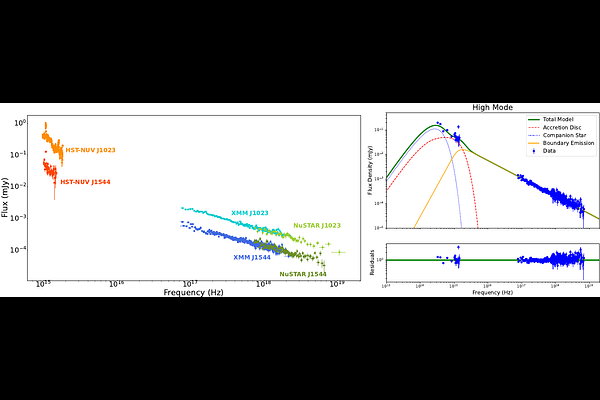Probing multi-band variability and mode switching in the candidate transitional millisecond pulsar 3FGL J1544.6-1125

Probing multi-band variability and mode switching in the candidate transitional millisecond pulsar 3FGL J1544.6-1125
Giulia Illiano, Francesco Coti Zelati, Arianna Miraval Zanon, Alessandro Papitto, Maria Cristina Baglio, Domitilla de Martino, Stefano Giarratana, Filippo Ambrosino, Francesco Carotenuto, Sergio Campana, Alessio Marino, Nanda Rea, Diego F. Torres, Marcello Giroletti, Thomas D. Russell, Christian Malacaria, Caterina Ballocco, Enrico Bozzo, Carlo Ferrigno, Riccardo La Placa, Adriano Ghedina, Massimo Cecconi, Francesco Leone
AbstractWe present the most extensive high-time resolution multi-band campaign to date on the candidate transitional millisecond pulsar (tMSP) 3FGL J1544.6-1125 in the sub-luminous disk state, with coordinated observations from the radio to the X-ray band. While XMM-Newton and NuSTAR X-ray light curves exhibit the characteristic high- and low-mode bimodality, the source faintness prevents firm evidence for similar bimodality in the ultraviolet and near-infrared light curves, presented here for the first time. A re-analysis of archival XMM-Newton/OM data reveals an optical flare without an X-ray counterpart, likely originating from the outer accretion disk or the companion star. During our observations, no radio emission was detected, with a 3$\sigma$ flux density upper limit of 8 $\mu$Jy at 6 GHz. While past works have already reported radio variability in the source, this limit is a factor of 3.5 below the average value measured in 2019 in similar conditions, underscoring significant radio variability despite the relatively stable X-ray flux. Simultaneous optical light curves in five filters with GTC/HiPERCAM revealed flickering and dipping activities that resemble the observed X-ray variability, along with a reddening trend at lower fluxes. The latter is consistent with discrete mass ejections that disrupt the inner flow and reduce both X-ray and optical fluxes, thereby driving the high-to-low-mode switches. This suggests a common origin for most optical and X-ray emission at the boundary region between the pulsar wind and the inner disk, as also supported by our modelling of the spectral energy distribution in the high mode. Overall, our findings reinforce the mini-pulsar nebula picture for tMSPs in the sub-luminous state and demonstrate how coordinated, high-time resolution, multi-wavelength campaigns are essential to probe the processes governing rapid mode switches in these systems.